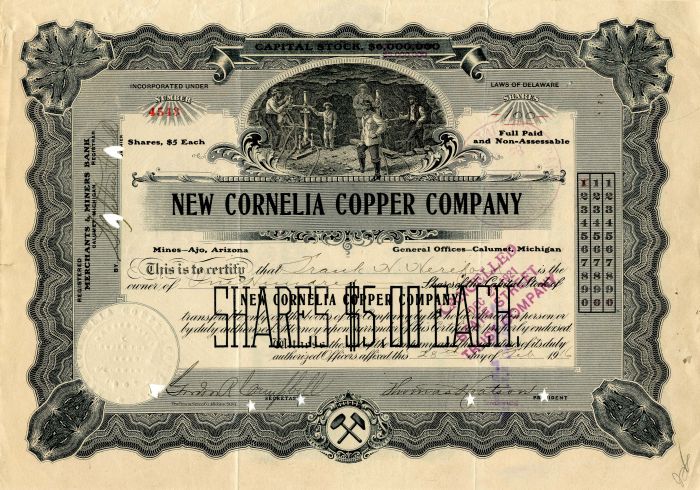New Cornelia Copper Co. - Stock Certificate
Inv# MS1263 Stock
Delaware
Michigan
The AJO DISTRICT is is in western Pima County, 125 miles west of Tucson. Small-scale mining of copper deposits was done by Spaniards and Mexicans as early as 1750, and Indians used the red oxides and green carbonates from the Sierra Del Ajo to paint their bodies. Americans entered the area after the Gadsden Purchase of 1853 and located the Ajo mine. After a boundary dispute with Mexico was settled, numerous attempts at mining were made, but all ended in failure due to high freight costs and lack of water. In 1909 three companies conducted separate exploration programs, none of which was considered encouraging. The Calumet and Arizona Copper Co. entered the district in 1911 and organized the New Cornelia Copper Co., which found a large tonnage of carbonate ore containing 1 to 2 percent of copper underlain by sulfide ore containing disseminated chalcopyrite and bornite. Drilling later revealed considerable ore on other properties. Experiments to leach and recover copper from the carbonate ore were started in 1912 and were concluded successfully in 1915. By 1917 a 5,000-ton leaching plant was built, permitting large-scale exploitation of the carbonate ores. After the exhaustion of the known reserves of carbonate ores, a 5,000-ton sulfide concentrator was put into operation in 1923, and production from the sulfide ores soon became predominant. In 1931 the New Cornelia Copper Co. was merged with the Phelps Dodge Co. which continued to be the sole operator in the district through 1959. Significant recovery of gold began with the production of copper from the sulfide ore of the New Cornelia mine. Prior to 1924 the district produced only 178 ounces. From 1924 through 1934 about 130,000 ounces was recovered, and from 1935 through 1959 about 860,000 ounces was recovered. The total gold production of the district through 1959 was about 990,000 ounces.
A stock certificate is issued by businesses, usually companies. A stock is part of the permanent finance of a business. Normally, they are never repaid, and the investor can recover his/her money only by selling to another investor. Most stocks, or also called shares, earn dividends, at the business's discretion, depending on how well it has traded. A stockholder or shareholder is a part-owner of the business that issued the stock certificates.









Ebay ID: labarre_galleries